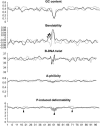Minos as a genetic and genomic tool in Drosophila melanogaster
- PMID: 15972463
- PMCID: PMC1456772
- DOI: 10.1534/genetics.105.041848
Minos as a genetic and genomic tool in Drosophila melanogaster
Abstract
Much of the information about the function of D. melanogaster genes has come from P-element mutagenesis. The major drawback of the P element, however, is its strong bias for insertion into some genes (hotspots) and against insertion into others (coldspots). Within genes, 5'-UTRs are preferential targets. For the successful completion of the Drosophila Genome Disruption Project, the use of transposon vectors other than P will be necessary. We examined here the suitability of the Minos element from Drosophila hydei as a tool for Drosophila genomics. Previous work has shown that Minos, a member of the Tc1/mariner family of transposable elements, is active in diverse organisms and cultured cells; it produces stable integrants in the germ line of several insect species, in the mouse, and in human cells. We generated and analyzed 96 Minos integrations into the Drosophila genome and devised an efficient "jump-starting" scheme for production of single insertions. The ratio of insertions into genes vs. intergenic DNA is consistent with a random distribution. Within genes, there is a statistically significant preference for insertion into introns rather than into exons. About 30% of all insertions were in introns and approximately 55% of insertions were into or next to genes that have so far not been hit by the P element. The insertion sites exhibit, in contrast to other transposons, little sequence requirement beyond the TA dinucleotide insertion target. We further demonstrate that induced remobilization of Minos insertions can delete nearby sequences. Our results suggest that Minos is a useful tool complementing the P element for insertional mutagenesis and genomic analysis in Drosophila.
Figures





References
-
- Altschul, S. F., W. Gish, W. Miller, E. W. Myers and D. J. Lipman, 1990. BASIC local alignment search tool. J. Mol. Biol. 215: 403–410. - PubMed
-
- Bellen, H. J., C. J. O'Kane, C. Wilson, U. Grossniklaus, R. K. Pearson et al., 1989. P-element mediated enhancer detection: a versatile method to study development in Drosophila. Genes Dev. 3: 1288–1300. - PubMed
-
- Berghammer, A. J., M. Klingler and E. A. Wimmer, 1999. A universal marker for transgenic insects. Nature 402: 370–371. - PubMed
Publication types
MeSH terms
Substances
LinkOut - more resources
Full Text Sources
Molecular Biology Databases

